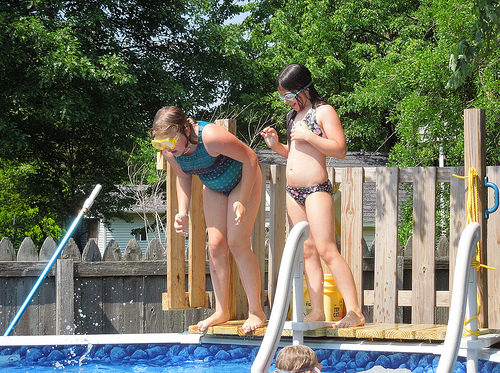
Do you have two swim or more students in your family or group or simply in sequence? Make the most of that with ZPD*! Sequences and groups offer a mix of observation, practice, and challenges through games or friendly competition. Each of these interactions provide deep benefits.
ENCOURAGE THEM TO WATCH
When children take lessons in sequence, encourage the child who has the second lesson to watch the first lesson. They often need no encouragement to watch because they are chomping at the bit to get in the pool with you.
When they watch you teach, it’s cool. But you’re a grown up. And a teacher. Of course, you can blow bubbles and dive under the water and kick and climb out of the pool. But seeing a kid—like them—do all those things makes them believe that they can do it too!—and, no offense, but that seeing has a more powerful impact than a thousand words from you. They see it for themselves. They know it’s true.
LET THEM SHINE
Invite children to shine. Asking children to demonstrate a skill makes them feel good, builds their confidence, and inspires them to their best: “I’m so good at this, teacher wants me to show everyone how it’s done!” (We’ll address OVER-confidence in a separate article.)
Will their examples be imperfect? Of course! In a way, that’s the point. Their “imperfect” examples are more valuable that your “perfect” one. When a child demonstrates, the child who is watching gets to see the “big pieces” of a skill on bodies of their own size. When the child who is watching hears you praise her peer, she gets excited about trying a new skill so she can earn that praise, too.
LET THEM TEACH
Ask them how they felt about the skill they just demonstrated. The child who is watching will compare those feelings to his own.
Ask them how they did it. When children describe their own actions, they tend to simplify and at the same time include critical details that adults omit. As the child who is watching listens to his peer’s description, he feels his body try those actions inside.
LET THEM COMPARE
Break out your stopwatch. Time breath-holds, kicks, swims, and pretty much any other skill. The child in the pool will strive to beat their record. The child who is watching may hold them up an example: “She held her breath for 8 seconds. I’m going for 10!”
LET THEM PLAY GAMES
Dove-tail lessons together with games—getting two children in the water to interact directly. Make sure caregivers are actively engaged during these overlaps.
Games are fun! Yes! But they also allow children 1) to unconsciously integrate skills and 2) to test and find their current limits.
Games organically bring together a lot of skills—kicking, paddling, treading, diving—but it’s easy to practice any skill you want to focus on by including it as part of “opening ritual.” For example, the person who is it has to spin around three time and count to five under the water.
What’s your role? Check out their skills. Which ones are becoming “muscle memory”? Which ones are still cast aside for “bad habits”?
LET THEM COMPETE
If they want to compete, organize a friendly—very friendly—and safe—very safe—competition. The desire to compete can come and go on a lesson by lesson basis—be ready for that! Make sure the competition is not all about one student showing up another. Mix up the skills so each child has a chance to shine: the back float is a good one—younger children often do this better than anyone else—including adults!
LET THEM TEST LIMITS
Games and competition often lead children beyond their comfort zones and even beyond their limits. Be ready to lend a hand to get a wall or a step or just to get oriented and catch a breath.
Stress that everyone in the water needs to know their limits—even you—and have someone there to help them when they get beyond them—because our limits are not fixed. They change depending on how we feel. In particular, they get smaller when we are tired—and the longer we stay in the pool.
Children should explore and test and really get a good understanding where their current limits are ONLY when you are in the water with them. Stress that you keep them safe when you are in water with them, but knowing their limits keeps them safe when you are not.
NETWORK
Do you have a child that’s not part of a group yet but you think might really benefit from one? Suggest a connection. Make sure that both parties are interested and then ask specifically for permission before sharing contact information.
Thanks for listening. I’m always interested in new ideas about how to make the most of sequential and group lessons. Please leave comments and suggestions here!
Cheers!
About the Author: Robert Rogers
Robert is a Sunsational Swim Instructor in Santa Rosa, California.
In his work life, Robert has taught people how to sing, act, and swim—and birds how to fly. Okay, well not exactly. But he did train birds for shows at state fairs, zoos, and Disney’s Animal Kingdom. His only regret is not having learned how to fly himself—yet! You have to crawl before you can fly—or butterfly, right? Favorite animal movie of the moment: EIGHT BELOW!
Book your lesson with Robert or any of our swim instructors!
ABOUT SUNSATIONAL SWIM SCHOOL
Sunsational Swim School is the 🥇 #1 rated provider of private, at-home swimming lessons in America. We have specialized swim instructors for students ages 6 months to adult, beginner to advanced. Featured on ABC, CBS, Impact 100, The List and others, Sunsational instructors have a minimum of 2 years of teaching experience, are CPR certified and insured, and have collectively taught over 302,223 lessons for more than 74,415 students nationwide!

